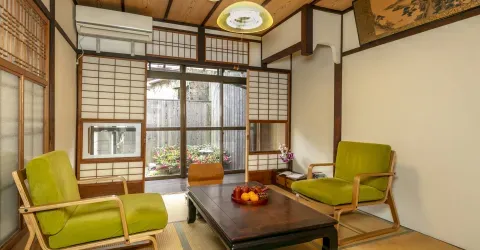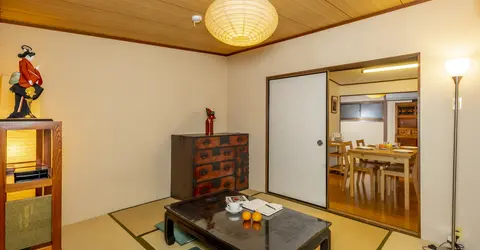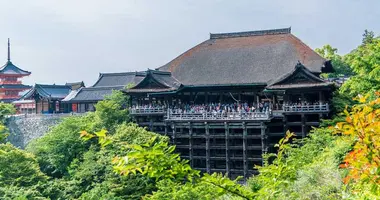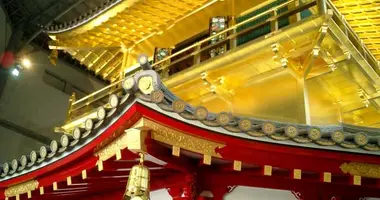Shugakuin Rikyu Imperial Villa Kyoto
- Published on : 25/12/2012
- by : Japan Experience
- Youtube
Shugakuin RIkyu Imperial Villa (Shugakuin Rikyu) 修学院離宮
Text and photos by Aliona Jefimova

Shugakuin Imperial Villa (Shugakuin Rikyu), North East Kyoto
Shugakuin Rikyu is an imperial villa that was built in the mid-17th century for the retired Emperor Gomizuno-o in the Higashiyama district of northeast Kyoto, so that he could enjoy the beauty of the natural surroundings. It is a place of breathtaking beauty and a wonderful example of the art of the Japanese garden.
The best time of the year to visit Shugakuin is autumn (late October-early December), when the fall leaves are changing color. Although Shugakuin Imperial Villa covers a vast area of land - approximately 545,000 m (135 acres) - it was built surprisingly quickly for the times, taking only 4 years, from 1655 to 1659, to complete.
Lower Villa

Bridge near the Upper Villa
Visiting Shugakuin Rikyu Imperial Villa is only possible by pre-arranging a tour. After watching an introductory video (in Japanese with English subtitles), our group headed for Miyuki-mon - the Lower Villa gate. Having passed a magnificent garden with a small pond and stone lanterns of various shapes, we stopped near Jugetsu-kan - the Lower Villa building. This is where the Emperor Gomizuno-o would rest before going on to the Upper Villa.
The main room has a sliding door painting by the renowned Zaichu Hara (1750-1837) as well as a wooden tablet with calligraphy by the Emperor Gomizuno-o himself.
Upon leaving the Lower Villa, it felt as though we had been transported to a 17th century Japanese village. Vast rice fields with mountains in the background spread before us. This land was purchased in 1964 in order to preserve the original landscape.
Middle Villa
After the Lower Villa, we took a path - originally between rice paddies - and headed for the Middle Villa. This consists of two buildings - Rakushi-ken and Kyaku-den. The Middle Villa was built not for the Emperor Gomizuno-o but for the Princess Genyo (Akenomiya) in the second half of the 17th century.
Kyaku-den has decorative shelves that are regarded as one of the "three most treasured shelves" in Japan. There are also cedar wood sliding doors depicting carp, as well as scenes from the Gion Festival - Kyoto's most well known festival, which takes place every July 17.

Shugakuin Rikyu Imperial Villa (Shugakuin Detached Palace), Kyoto
Upper Villa

Shugakuin Rikyu Upper Villa
We then ascended a hill to the Upper Villa - the spot with the most dramatic view. Until you reach the summit, however, trees obstruct the view.
Typical of Japanese garden design, the paths are winding, with numerous surprises waiting just round a corner. Finally, we arrived at the top.
There was a panoramic view of Kyoto in the distance, fall colors, mountains, a waterfall, and, nearby, a beautiful pond with an island in the middle.
The teahouse Rinun-tei is situated at the highest point of the Upper Villa, and is designed so that nothing will distract the visitor from enjoying nature. There are neither decorative shelves nor an alcove inside the teahouse. It is said that while sitting here, observing the natural landscape and listening to the sounds of the waterfall, the ideas in one's head are transformed unconsciously into Japanese poetry.
After this, we headed towards Kyusui-tei - the only building that remains intact from the times of Emperor Gomizuno-o. He would sit here and enjoy the landscape or recite Japanese poetry. Here, too, is a wooden tablet with calligraphy by the Emperor.

Shugakuin Imperial Villa (Shugakuin Rikyu), Kyoto

Shugakuin Imperial Villa (Shugakuin Rikyu), Kyoto
Finally, we walked around the pond, making our way back to the Lower Villa. On our way, we saw a boat (the Emperor Gomizuno-o liked boating) and the splendid Chitose-bashi (top right), a covered bridge built in 1824 for the Emperor Kakaku.
How to apply for a visit to Shugakuin Villa
To visit Shugakuin Rikyu, permission from the Imperial Household Agency is required. To apply, go to the Agency office in the northwestern part of the Kyoto Imperial Park (Gosho). Alternatively, you can apply online:
You will be given a specific time and date on which your tour will begin. Do not come late. You should come to the destination 10 minutes prior to the departure of the tour.
Guided tours in Shugakuin Villa are in Japanese only, but there are audio guides available in English.
The tour and the audio guides are both free.
Things to remember when visiting Shugakuin:
- Reservations are required. Do so as far in advance as possible.
- Fall (late-October to December) is the most crowded time of year.
- Arrive before your appointed tour time. If you are late, you will not get in.
- Wear comfortable shoes.

Chitose Bridge
Shugakuin Access
Walk up the hill from Shugakuin Station on the Eiden Line from Demachiyanagi Station or take a number #5 bus to the stop just outside the Kyoto University Foreign Students' Residence.
Shugakuin Map
Other Japan Articles by Aliona Jefimova
Japanese Gift-Giving
Katsura Imperial Villa
Jidai Matsuri, the Festival of the Ages
Kyoto's Nishijin Textile Centre
Kyoto Hotels
Books on Japanese Gardens
Books on Kyoto Japan
Shugakuin Rikyu Imperial Villa. Read about Kyoto's Shugakuin Rikyu Imperial Villa. Shugakuin Imperial Villa is a royal palace in east Kyoto famous for its gardens.





























